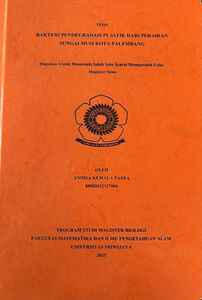TASYA, ANNISA KEMALA and Widjajanti, Hary and Hanum, Laila (2025) BAKTERI PENDEGRADASI PLASTIK DARI PERAIRAN SUNGAI MUSI KOTA PALEMBANG. Masters thesis, Sriwijaya University.
![[thumbnail of RAMA_46101_08082622327004_Cover.jpeg]](https://repository.unsri.ac.id/170148/20.hassmallThumbnailVersion/RAMA_46101_08082622327004_Cover.jpeg)  Preview |
Image
RAMA_46101_08082622327004_Cover.jpeg - Cover Image Available under License Creative Commons Public Domain Dedication. Download (429kB) | Preview |
|
Text
RAMA_46101_08082622327004.pdf - Accepted Version Restricted to Repository staff only Available under License Creative Commons Public Domain Dedication. Download (5MB) | Request a copy |
|
|
Text
RAMA_46101_08082622327004_TURNITIN.pdf - Accepted Version Restricted to Repository staff only Available under License Creative Commons Public Domain Dedication. Download (5MB) | Request a copy |
|
|
Text
RAMA_46101_08082622327004_0012126112_0031087304_01_front_ref.pdf - Accepted Version Available under License Creative Commons Public Domain Dedication. Download (1MB) |
|
|
Text
RAMA_46101_08082622327004_0012126112_0031087304_02.pdf - Accepted Version Restricted to Repository staff only Available under License Creative Commons Public Domain Dedication. Download (326kB) | Request a copy |
|
|
Text
RAMA_46101_08082622327004_0012126112_0031087304_03.pdf - Accepted Version Restricted to Repository staff only Available under License Creative Commons Public Domain Dedication. Download (392kB) | Request a copy |
|
|
Text
RAMA_46101_08082622327004_0012126112_0031087304_04.pdf - Accepted Version Restricted to Repository staff only Available under License Creative Commons Public Domain Dedication. Download (661kB) | Request a copy |
|
|
Text
RAMA_46101_08082622327004_0012126112_0031087304_05.pdf - Accepted Version Restricted to Repository staff only Available under License Creative Commons Public Domain Dedication. Download (34kB) | Request a copy |
|
|
Text
RAMA_46101_08082622327004_001216112_0031087304_06_ref.pdf - Bibliography Restricted to Repository staff only Available under License Creative Commons Public Domain Dedication. Download (257kB) | Request a copy |
|
|
Text
RAMA_46101_08082622327004_0012126112_0031087304_07_lamp.pdf - Accepted Version Restricted to Repository staff only Available under License Creative Commons Public Domain Dedication. Download (3MB) | Request a copy |
Abstract
Polyethylene plastic has properties that are difficult to degrade in the environment and pollute the ecosystem. Biodegradation by bacteria is a potential solution by utilizing enzymes that break down plastic polymers. This degradation process is observed using Scanning Electron Microscopy (SEM) to see changes in the plastic structure such as holes and cracks. To determine the type of degrading bacteria, microscopic and macroscopic observations were carried out. Microscopic observations include analysis of bacterial cell morphology, while macroscopic observations include colony characterization, such as color, shape, and texture and are reinforced with molecular identification to determine the bacterial species that play a role in plastic degradation. The purpose of this study was to obtain plastic degrading bacteria found in the Musi River, Palembang City, to examine the potential of plastic degrading bacteria in the waters of the Musi River, Palembang City, and to analyze the characteristics and identities of plastic degrading bacteria from the waters of the Musi River, Palembang City based on phenotype and molecular. This research was conducted in October 2023 - October 2024 at the Microbiology Laboratory of UIN Raden Fatah Palembang and the Microbiology Laboratory of the Biology Department, FMIPA, Sriwijaya University. The research methods used were sampling, isolation and purification of bacteria, plastic degradation tests, phenotypic and molecular characterization and identification of bacteria that had a high percentage of degradation. The results showed that of the 33 bacterial isolates obtained, 6 isolates were selected for the plastic degradation test for 60 days. The degradation test showed the percentage of degradation respectively 38.03%, 34.73%, 30.46%, 23.97%, 23.80%, and 20.90% in sample codes S2I1, S1I5, S1I3, S1I2, S3I1, and S3I5. Observations using a Scanning Electron Microscope (SEM) showed holes and cracks on the plastic surface, indicating that the bacteria have the ability to degrade plastic. Phenotypic characterization of isolates with high degradation ability showed that isolates S1I3, S1I5, and S2I1 were related to the genus Bacillus. These results were supported by molecular identification, where the three isolates with the highest degradation rate showed that isolate S1I3 had similarities with Bacillus proteolyticus with a percent identity of 99.9%, while isolates S1I5 and S2I1 had similarities with Bacillus cereus with a percent identity of 100%. Keywords: Biodegradation, plastic degrading bacteria, molecular identification, phenotypic characteristics, scanning electron microscope (SEM)
| Item Type: | Thesis (Masters) |
|---|---|
| Uncontrolled Keywords: | Sains, Bakteri Pendegradasi Plastik |
| Subjects: | Q Science > QR Microbiology > QR75-99.5 Bacteria |
| Divisions: | 08-Faculty of Mathematics and Natural Science > 46101-Biology (S2) |
| Depositing User: | Annisa Kemala Tasya |
| Date Deposited: | 26 Mar 2025 03:18 |
| Last Modified: | 26 Mar 2025 03:18 |
| URI: | http://repository.unsri.ac.id/id/eprint/170148 |
Actions (login required)
 |
View Item |
